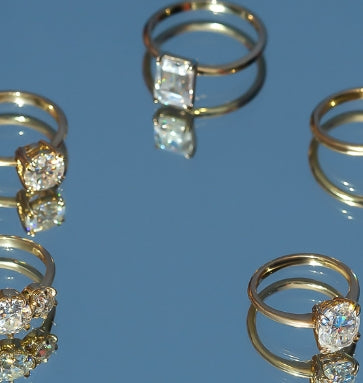What is a Lab-Grown Diamond?
Hera works only with lab-grown stones in our engagement rings and fine jewelry. You’ve probably heard of lab-grown diamonds before - but even if you have, you might not know what a lab-grown diamond really is (and that’s okay!).
Lab-grown diamonds are chemically, physically, and optically the same as mined diamonds. The only difference is that instead of being mined out of the earth, they’re grown in a lab. Even gemologists and jewelers need special equipment to tell the difference.
Are Lab-Grown Diamonds More Sustainable? Absolutely. Sustainability is a core part of our mission and lab-grown diamonds fit in perfectly. How? By avoiding mining, a known contributor of environmental destruction.

To keep it short,
mining is terrible
for the environment.
In 2020, a report conducted at American University and the University of Delaware found that “diamond mining proliferates deforestation and desertification, water pollution, and soil erosion and pollution” in Guinea, Sierra Leone, and Zimbabwe. Which is something we at Hera and Gaia are not a fan of - and therefore don’t support.
Even in countries with relatively strong environmental protections, diamond mining introduces a handful of environmental problems such as mining waste, acid drainage, and leaching of heavy metals into the environment. In fact, Mining Watch Canada released a map in January 2021 showing over 100 contaminated mine waste sites in British Columbia alone. Yuck.
How Are Lab-Grown Diamonds Grown?
They grow from seeds! No joke, lab-grown diamonds are cultivated using tiny seeds of existing diamonds. By mimicking the natural conditions under which diamonds grow, we can use technology to turn those seeds into diamonds.
There are two methods of growing a diamond:
1
High Pressure
High Temperature
In the High Pressure High Temperature, or HPHT growth process, diamond seeds are placed in carbon and exposed to extreme heat and pressure, essentially replicating the underground conditions that facilitate diamond growth
2
Chemical Vapor
Deposition
Chemical Vapor Deposition, or CVD diamonds are grown by heating diamond seeds in a chamber with carbon-rich gases. Both methods produce beautiful diamonds.

WORKING WITH AN EXPERT MATTERS
When shopping for a lab-grown diamond, there are some things to watch out for depending on which process the grower used. HPHT diamonds can have a blue tint if there is excess boron in the diamond, and CVD diamonds can have a brown undertone (as opposed to natural yellow) if they were grown too quickly.
That’s why it’s important to work with a lab-grown diamond expert when selecting your stone.
How to Shop for The Perfect
Lab-Grown Diamond

As our client, you have two options when purchasing a lab-grown diamond. You’ll either choose from upgrading to a lab-grown diamond with our available styles (no extra effort on your part). Or, you can choose our concierge service.